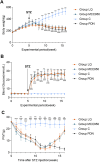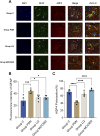Liquiritin ameliorates painful diabetic neuropathy in SD rats by inhibiting NLRP3-MMP-9-mediated reversal of aquaporin-4 polarity in the glymphatic system
- PMID: 39295943
- PMCID: PMC11408323
- DOI: 10.3389/fphar.2024.1436146
Liquiritin ameliorates painful diabetic neuropathy in SD rats by inhibiting NLRP3-MMP-9-mediated reversal of aquaporin-4 polarity in the glymphatic system
Abstract
Background: Despite advancements in diabetes treatment, the management of Painful Diabetic Neuropathy (PDN) remains challenging. Our previous research indicated a significant correlation between the expression and distribution of Aquaporin-4 (AQP4) in the spinal glymphatic system and PDN. However, the potential role and mechanism of liquiritin in PDN treatment remain uncertain.
Methods: This study established a rat model of PDN using a combination of low-dose Streptozotocin (STZ) and a high-fat, high-sugar diet. Rats were treated with liquiritin and MCC950 (an NLRP3 inhibitor). We monitored fasting blood glucose, body weight, and mechanical allodynia periodically. The glymphatic system's clearance function was evaluated using Magnetic Resonance Imaging (MRI), and changes in proteins including NLRP3, MMP-9, and AQP4 were detected through immunofluorescence and Western blot techniques.
Results: The rats with painful diabetic neuropathy (PDN) demonstrated several physiological changes, including heightened mechanical allodynia, compromised clearance function within the spinal glymphatic system, altered distribution of AQP4, increased count of activated astrocytes, elevated expression levels of NLRP3 and MMP-9, and decreased expression of AQP4. However, following treatment with liquiritin and MCC950, these rats exhibited notable improvements.
Conclusion: Liquiritin may promote the restoration of AQP4 polarity by inhibiting NLRP3 and MMP-9, thereby enhancing the clearance functions of the spinal cord glymphatic system in PDN rats, alleviating the progression of PDN.
Keywords: aquaporin-4; glymphatic system; liquiritin; matrix metalloproteinase-9; painful diabetic neuropathy.
Copyright © 2024 Jia, Yin, Xu, Li, Yan and Lin.
Conflict of interest statement
The authors declare that the research was conducted in the absence of any commercial or financial relationships that could be construed as a potential conflict of interest.
Figures






Similar articles
-
Ginkgolide B can alleviate spinal cord glymphatic system dysfunction and provide neuroprotection in painful diabetic neuropathy rats by inhibiting matrix metalloproteinase-9.Neuropharmacology. 2024 Jun 1;250:109907. doi: 10.1016/j.neuropharm.2024.109907. Epub 2024 Mar 14. Neuropharmacology. 2024. PMID: 38492884
-
β-Hydroxybutyrate Attenuates Painful Diabetic Neuropathy via Restoration of the Aquaporin-4 Polarity in the Spinal Glymphatic System.Front Neurosci. 2022 Jul 11;16:926128. doi: 10.3389/fnins.2022.926128. eCollection 2022. Front Neurosci. 2022. PMID: 35898407 Free PMC article.
-
Plasticity of the spinal glymphatic system in male SD rats with painful diabetic neuropathy induced by type 2 diabetes mellitus.J Neurosci Res. 2022 Oct;100(10):1908-1920. doi: 10.1002/jnr.25104. Epub 2022 Jul 7. J Neurosci Res. 2022. PMID: 35796387 Free PMC article.
-
Diabetic painful and insensate neuropathy: pathogenesis and potential treatments.Neurotherapeutics. 2009 Oct;6(4):638-47. doi: 10.1016/j.nurt.2009.07.004. Neurotherapeutics. 2009. PMID: 19789069 Free PMC article. Review.
-
Diabetic Neuropathy Pain Management: A Global Challenge.Curr Diabetes Rev. 2021;17(5):e031120187542. doi: 10.2174/1573399816666201103142521. Curr Diabetes Rev. 2021. PMID: 33143631 Review.
Cited by
-
Qifuyin against CCL11-Induced cognitive impairment by inhibiting microglial senescence via CCR3 signaling.Immun Ageing. 2025 Jul 17;22(1):31. doi: 10.1186/s12979-025-00528-6. Immun Ageing. 2025. PMID: 40676694 Free PMC article.
-
Chaihuang Qingfu Pills Protect Against Acute Pancreatitis-Associated Acute Lung Injury Through MMP9-NLRP3-Pyroptosis Pathway.J Inflamm Res. 2025 Feb 18;18:2317-2338. doi: 10.2147/JIR.S501531. eCollection 2025. J Inflamm Res. 2025. PMID: 39991664 Free PMC article.
-
Changes of intestinal microbiome and its relationship with painful diabetic neuropathy in rats.BMC Microbiol. 2025 May 8;25(1):281. doi: 10.1186/s12866-025-04015-2. BMC Microbiol. 2025. PMID: 40335921 Free PMC article.
References
-
- Aman U., Subhan F., Shahid M., Akbar S., Ahmad N., Ali G., et al. (2016). Passiflora incarnata attenuation of neuropathic allodynia and vulvodynia apropos GABA-ergic and opioidergic antinociceptive and behavioural mechanisms. BMC Complement. Altern. Med. 16, 77. 10.1186/s12906-016-1048-6 - DOI - PMC - PubMed
-
- Amutha A., Ranjit U., Anjana R. M., Shanthi R. C., Rajalakshmi R., Venkatesan U., et al. (2021). Clinical profile and incidence of microvascular complications of childhood and adolescent onset type 1 and type 2 diabetes seen at a tertiary diabetes center in India. Pediatr. Diabetes 22 (1), 67–74. 10.1111/pedi.13033 - DOI - PubMed
-
- An J., Nichols G. A., Qian L., Munis M. A., Harrison T. N., Li Z., et al. (2021). Prevalence and incidence of microvascular and macrovascular complications over 15 years among patients with incident type 2 diabetes. BMJ Open Diabetes Res. Care 9 (1), e001847. 10.1136/bmjdrc-2020-001847 - DOI - PMC - PubMed
LinkOut - more resources
Full Text Sources
Miscellaneous

